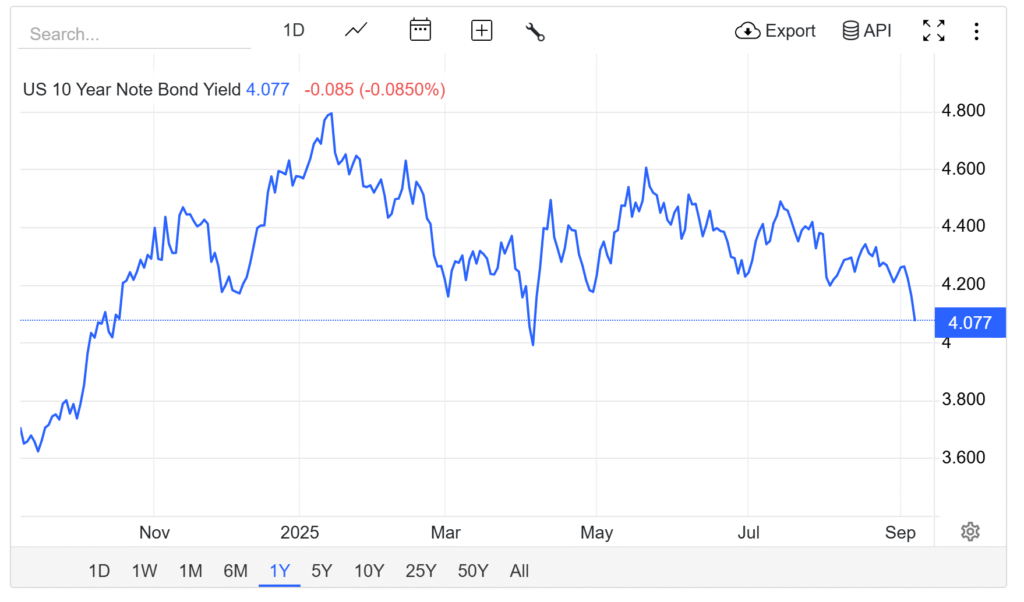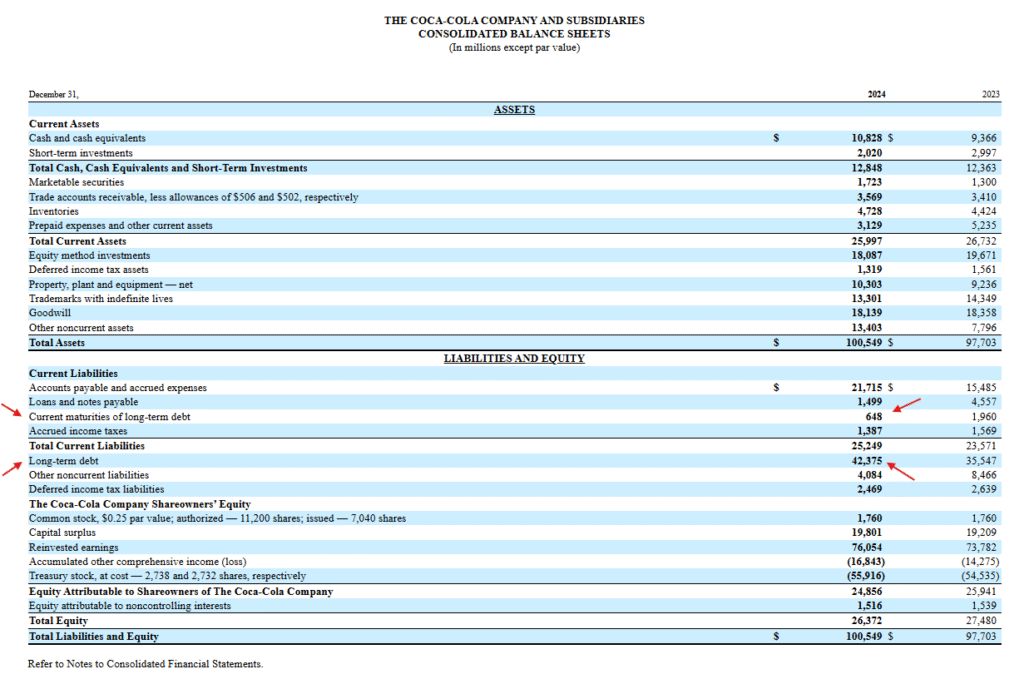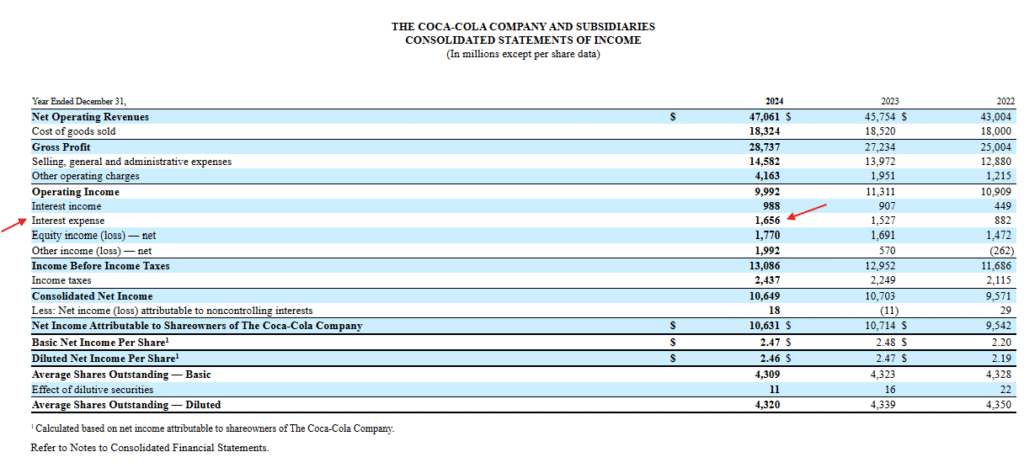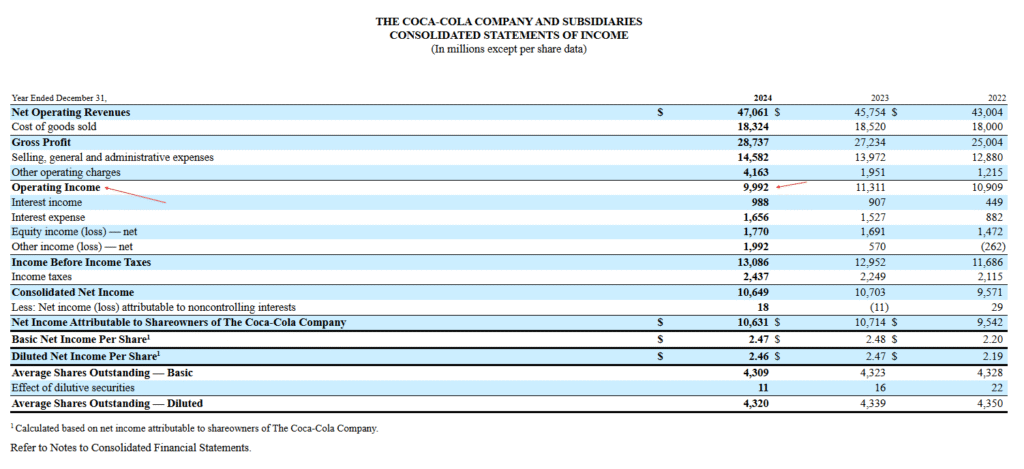Introduction
In this post I’ll guide you step-by-step through a Cost of Capital calculation. We’ll use Coca-Cola as our choice company for that.
To start, let’s acess the Cost of Capital – Calculator on the Resource tab: https://thefairvaluejournal.com/cost-of-capital-calculator/

Here you’ll find multiple inputs ready for you to enter them.

At the end of that process it will output a Cost of Capital (WACC) , a Cost of Equity and a Cost of Debt.
Cost of Equity
The Cost of Equity is the rate of return that an investor requires from an equity investment in a firm.
It’s mostly used during the calculation of the Cost of Capital but it’s also used alone for the valuation methods using Dividends (DDM – Stable Growth and DDM – Variable Growth).
Its formula is the following:
Cost of Equity = Risk-Free Rate + Beta (Risk Premium)
- Risk-Free Rate
- the rate that investors can make on riskless investments;
- it’s recommended the use of the 10-Year bond yield of the country that generates the currency where the company is incorporated in;
- a direct input on the Cost of Capital – Calculator (explained in a later section).
- Beta
- the risk that the respective company represents;
- calculated in the background using the industries the respective company operates in and the debt / equity ratio.
- Risk Premium (Equity Risk Premium or ERP)
- the premium investors should expect in investing in riskier investments;
- calculated in the background using the revenue exposure / allocation by regions / countries.
Cost of Debt
The Cost of Debt is the rate that measures the cost to the firm for borrowing funds.
Its formula is the following:
Cost of Debt = Pretax Cost of Debt (1 - Tax Rate)
- Pretax Cost of Debt
- Risk-Free Rate multiplied by the Spread associated with the Rating the company has;
- calculated in the background using the Risk-Free Rate and the Rating input.
- Tax Rate
- direct input on the Cost of Capital – Calculator.
Cost of Capital
The Cost of Capital (or Weighted Average Cost of Capital – WACC) is the weighted average of the costs for the different components in financing, both Equity and Debt.
The cost of capital calculation after having the Cost of Equity and Cost of Debt is very easy. Just multiply each Cost by its weight relative to the Capital Value.
Example:
Capital Value = Total Equity + Total Debt
Equity Weight = Total Equity / Capital Value
Debt Weight = Total Debt / Capital Value
Cost of Capital = Equity Weight * Cost of Equity + Debt Weight * Cost of Debt
Inputs
Select Industry
The first input you’ll need to fill in is the industry. Please select the closest one you can find that describes your company the best.

For Coca-Cola, I’ve selected Beverage (Soft).

Risk-Free Rate
The risk free rate used should be the today’s long term risk-free rate. By norm you should use the 10-Year bond yield of the currency of the country your company is incorporated in.
For example:
- U.S. Company – use the Dollar risk-free rate, that would be the 10-Year bond yield of the United States;
- Portugal Company – use the Euro risk-free rate, that would be normally the 10-Year bond yield of Germany (or France);
- Denmark Company – use the Danish Krone risk-free rate, so the Denmark 10-Year bond yield.
And so on, you can extrapolate that into other countries.
You can find the 10-Year bond yield for any country easily online, in my case I’ve found the risk-free rate for Coca-Cola using the 10-Year bond yield for the U.S. here on this link. But please feel free to find your own sources, but please make it consistent across valuations.
So for Coca-Cola the risk-free rate at the moment of the writing of this post is 4.077%


Total Debt
This should be all interest bearing debt both short and long-term for the respective company.
You can find this on the company balance sheet. Here for Coca-Cola, I’ve open up its 10-K, and summed up the Current maturities of long-term debt and the Long-term debt for the last year:

Giving a Total Debt of 43023.

It’s very important that you be consistent with the units you use for your inputs. If you’re using Millions, please use Millions across all your valuations methods and tools.
For this Coca-Cola calculation I’m using Millions, the same units the 10-K is using.
Interest Expenses
These are the expenses the company has with their borrowings of money.
You can find this normally under the income statement or as a note to the financial statement (you can try the search tool to find this).
For Coca-Cola I was able to get this value under the income statement:

Giving an Interest Expense of 1656.

Terminal Tax Rate
This is the Tax Rate you expect the company to converge into.
You will see a suggestion popping up below the input box:

This will tell you the average Terminal Tax Rate for companies in your indicated industry. By norm you should stick to this, but you have the liberty to input anything you need if you need so.
For this example I’ll stick with the 18.73% recommended for a company like Coca-Cola in the Beverage (Soft) industry.

Shares Outstading
The number of shares outstanding for your company. If your company has many classes of shares, please sum them all and input them here.
You’ll find this value at the beginning / front page of the annual / quarterly reports. For this value you should always use the value from the most recent report.

Please make sure to maintain your units here. Coca-Cola has 4301000395 total shares outstanding. Given the fact that I’m using all inputs in Millions, I’ll use 4301.000395.

Current Market Price
As the name says it’s the current price that the company is trading at. You can find this value in yahoo finance, tradingview, and many others.
At the time of the writing this post, Coca-Cola was trading at $67.96.

Revenue Allocation (Industries)
Here you’ll need to indicate the industries where your company operates.
Does your company sells shoes and clothing? Is your company a cloud provider but it’s also making games? Here you’ll have the freedom to input all of those but make sure you have the revenues for each industry/segment.
You may find more information on the notes for the financial segments.
Given the single business nature of Coca-Cola and the fact that its revenues are exposed globally in many countries/regions, I’ll choose the Single Business (Global) option, but please be free to choose the most relevant option for your company.

Revenue Allocation (Countries/Regions)
This time you’ll input how the company describes its revenues allocation by geographic segments. Some companies show the distribution by Country, others by Region.
As with the Industry / Segments allocation, the companies normally report this on their notes to the financial statements.
Below it’s the example for Coca-Cola:

As you can see, Coca-Cola reports based on regions: Europe, Middle East & Africa , Latin America , North America , Asia Pacific , Global Ventures.
I’ll select Regions:

Then, go and add the Region and its associated revenue:

As you see above you may need to divide some of the geographic segments in multiple regions (Europe, Middle East and Africa for example). Please make it as best as you can, but there’s no perfection here.
This will be used for the Equity Risk Premium calculation and will provide a good input into the revenue risk some companies may present. For example, if a company has most of its revenues from Africa, these revenues have more risk to them than other company that has most revenues in North America or Europe. All of this will be taken into account on the Cost of Equity calculation and after on the Cost of Capital calculation.
Average Maturity of Debt
The average maturity, in years, for the debt of the company. Companies sometimes provide you this on their notes to financial statements, namely on the Debt section.
If you cannot find this please leave this as 0.
I was not able to find this for Coca-Cola, so I’ve set it to 0.

Rating
Here you’ll indicate if the Rating used for the Cost of Debt calculation will be an Actual Rating, where you’ll provide it via a dropdown, or an Estimated Rating, where the tool will try its best to estimate a possible rating for the company.
You check if the company has a rating and what that rating is on Moody’s for free, after login: link.
Actual Rating and Company Rating
If you found a rating for the company on Moody’s just select the Actual Rating option and its rating on the Company Rating dropdown.
At the moment of the writing of this post, Coca-Cola had a A1 rating from Moody’s. So I’ve selected Actual Rating and this rating on the Company Rating dropdown.

Estimated Rating and Operating Income (EBIT)
If the company you’re valuating does not have a rating from Moody’s you can also estimate it automatically. Just select the Estimated Rating option and indicate the company Operating Income (EBIT) on the other new input. The rating will be estimated and used in the background without any problems.
You can find the Operating Income normally on the Income Statement of the company reports.

Conclusion
And it’s done. Now just click on Calculate and the calculator will output the Cost of Capital , the Cost of Equity and the Cost of Debt of your company.
As you can see, Coca-Cola at this time has: Cost of Capital: 7.83% , Cost of Equity: 8.39% , Cost of Debt: 4.06%. This will be useful in any valuation or analysis I may do next.

